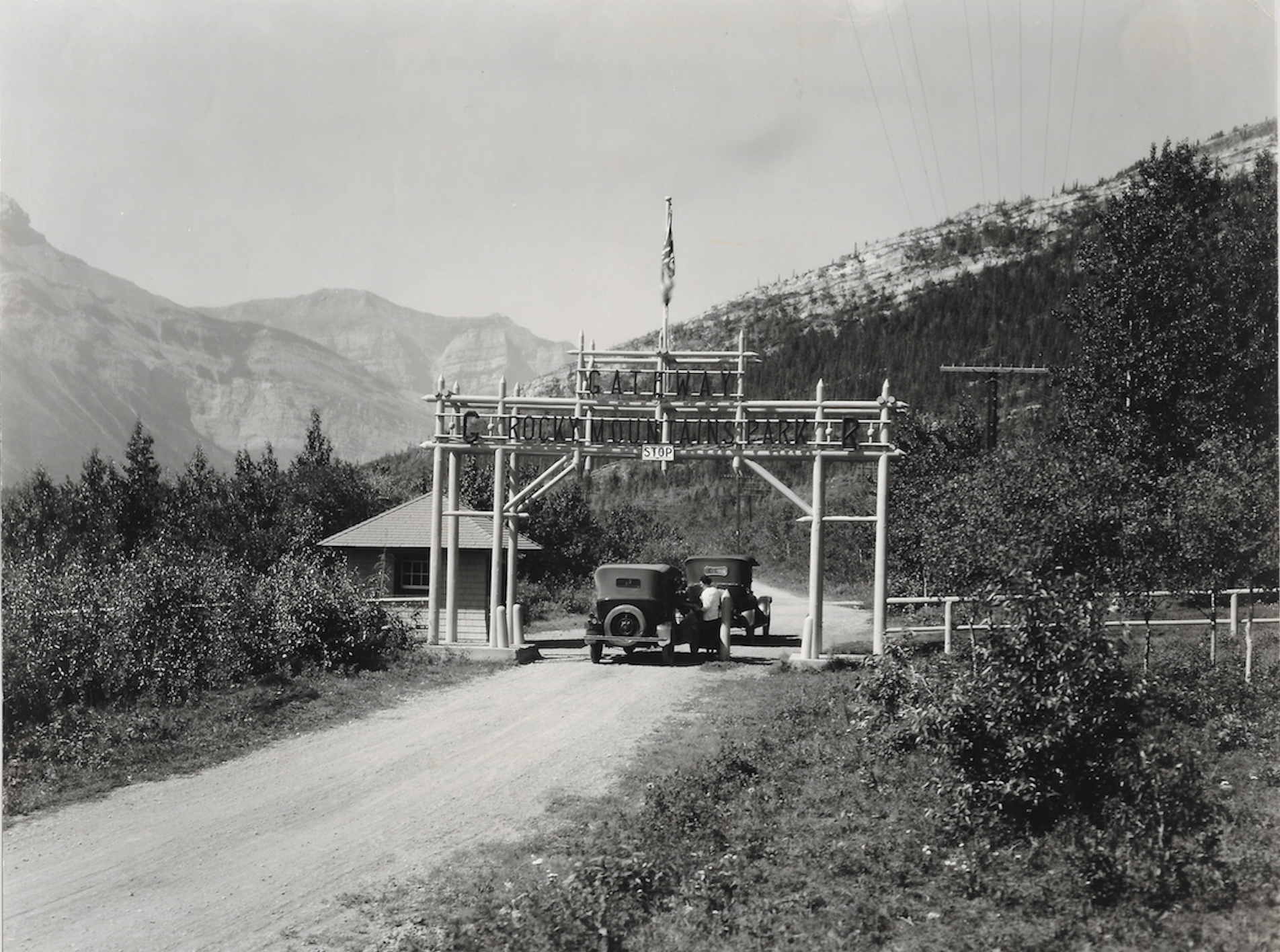ANNIE STAPLE: THE GUARDIAN OF THE GATES
By Meghan J. Ward
The Banff National Park East Gate holds a special significance for many people who come through it. And thanks to Annie Staple, there is an importance not only to the protected lands that lay beyond, but also to the history of the gates and the timber archway that once indicated the park’s eastern boundary. Here is the remarkable story of the park’s first gatekeeper, and why you should take a moment to think of Annie the next time you pass through.
The Gateway to Rocky Mountains Park. Photo: Staple Family Collection.
There was once a time when Banff National Park was Rocky Mountains Park, and the only road leading to it from Calgary was a dusty, bumpy dirt road.
Back in the ’20s, five hours was considered a “record” run on the remote road into Canada’s first national park. It would be hours before a car would arrive at the park boundary, which up until 1916 was nothing more than an invisible line. Then, the Warden Service took over the task of registering motorists – previously the responsibility of the RCMP and Superintendent in Banff – and they established the park’s first gate near Exshaw.
Greeting visitors at that gate and other Banff park gates for the next 32 years was Annie Staple.
Annie Staple (Jones) was born in Worcestershire, England, on March 30, 1883. She and her husband Tom married in 1907 and honeymooned to Canada, eventually settling in the new province of Alberta, where Tom got a construction job building the cement plant in Exshaw. Tom later worked as the postmaster and also for the warden service for Rocky Mountains Park, which was established in 1887 as an expansion of the Hot Springs Reserve in Banff. The boundaries of Rocky Mountains Park would change a number of times in the 43 years to follow before Banff National Park was established.
THE FIRST GATEKEEPER
In an age where over three million vehicles pass through the Banff park gates each year, it can be difficult to imagine a time when cars were not only scarce but discouraged. At the turn of the century, park management and local stakeholders weren’t in agreement about how to handle the increasing number of motorists wanting to drive in the park. This type of travel was a total novelty. Then, in 1916, after years of prohibition, restrictions and an onerous licensing system, the gate was established at the eastern boundary of Rocky Mountains Park, and Annie Staple was appointed a gatekeeper by the Warden Service, the gate’s only employee.
On August 14, 1909, Norman Lougheed was the first recorded motorist to tackle the eight-and-a-half-hour journey on the partly completed Calgary-Banff Coach Road. He drove into Banff during a prohibition on motor vehicles in the park, which lasted from 1905-1910, and was immediately charged by local police.
At this time, Annie had three children in her care – Joyce, Tom, and Geoff – and the family lived in a temporary tent (while Gateway Lodge was being built), which also served as the “gate” to the park until 1917. When a vehicle arrived, Annie meticulously recorded the driver’s name and address, the car’s model and colour, and the amount paid for entry – $1 for a week or $4 for a month. A far cry from the park passes issued today, the first park passes were large, reusable permit plates that were attached to the front and rear of the car with wire. As vehicles left the park, the plates were returned and, with the help of her children, Annie would wash them in a creek nearby and reuse them. In that first year, 786 vehicles registered at the gate.
“She was the first interpreter of Banff National Park,” said Annie’s granddaughter, Wendy Laing (Staple), who grew up in Banff and remembers visiting Grandma at the gate in its present-day location. “She used to get cards and letters from all over, from people who had passed through.”
LIFE AT THE GATES
In the fall of 1916, the Staple family moved into a more adequate five-room home they called “Gateway Lodge.” The following year, a timber archway was built to greet motorists to the park, and a small office was constructed for Annie. The archway, adorned at the top with a Union Jack, read “Gateway” and “Rocky Mountains Park”, with the letters “G” and “R” on either side in honour to King George V (George Rex).
Tragically, Tom Sr. died of heart failure in 1919, when Annie was pregnant with their fourth child, Albert. Now a single mother facing even more hardships and challenges, Annie remained the gatekeeper to Rocky Mountains Park, and developed a far-reaching reputation.
From Brantford Newspaper, Photo: Staple Family Collection.
For years, Annie greeted nearly every park visitor who came through the gates, sometimes waking in the middle of the night and heading out with the dog to give drivers their passes. Each car was issued a license plate, and later a round sticker that featured a different park animal each year. In 1925, the same year the metal buffalo permit plates came into use, Annie was issued her first-ever uniform – a navy blue dress, a jacket with brass buttons and a cap that she rarely wore. A tall, strong and kind woman, Annie enjoyed the niceties of life, had a positive impact on visitors, and proudly represented the park.
“I think she was one of the wonderful pioneer women in Canada,” said Wendy. “She didn’t set out to be a pioneer; she just was.”
Wendy remembers shopping for coats and shoes with Grandma in Calgary and bumping into previous park visitors at The Hudson’s Bay Company. According to Wendy, Annie had a phenomenal memory and would promptly spring into action: You’re ‘Mrs. So and So’ and you went through the gate in ’19xx’ and you were driving ‘this’ kind of car. Well, how are you? How have things been?!
“We’d have a whole conversation in the elevator, and people would remember her,” said Wendy.
ANNIE’S LEGACY
In the late ’20s, the gates became so busy that sons Tom and Geoff began working shifts. Annie became the Chief Gatekeeper, a title which she held until her retirement on March 31, 1948. She saw the park (and, by extension, the gates) go through various phases, including a reduction of the park’s size in 1930, which shifted the boundaries to their present-day location and prompted the renaming of the park to Banff National Park.
“I think it was in her own self-interest that she promoted the gate, made it easy for people to go through, and set up conversations with them. It kind of solidified the position. You almost wonder: if this came into place today and it was a brand new thing, what would the gate be? Would it be a toll gate on a parkway and you just toss in your toonie and away you go? There would be no personal interaction.”
The experience at the East Gate today, where people still stop to speak with Parks Canada staff, is because of Annie and the historic role she played.
A shift in the boundaries eleven miles West meant another big move for Annie. While the new park gates were being built in their current location, she lived in a shack at the temporary gates near Carrot Creek. Authorities thought the substandard living conditions would be too demanding for a widow with four children, so they relocated Annie to the western entrance at Yoho National Park, and later to the Upper Hot Springs. But, being the icon that Annie was, Banff residents started a petition to have her returned to the gates, and she was. The East Gate was simply not the same without Annie Staple. And she proved her strong spirit yet again when what was supposed to be six months of temporary living arrangements turned into six years while the new (current) gate was built.
The family at Gateway Lodge (Tom, Joyce, Geoff (father of Wendy and Karen), Albert (father or Ron and Greg), and Annie Staple). Photo: Staple Family Collection.
Ron Staple, Annie’s grandson, remembers sleeping over at the park gates, at Grandma’s. And not only are there few people who can say they have slept at the park gate, but as Ron said, “there are not too many people or families that can say they’ve had a connection with Banff National Park or Parks Canada for four generations.” Annie’s legacy with Parks Canada continues through her descendants, including one of her great-granddaughter’s, Susan, who works as a Parks Canada Interpretation Coordinator in Banff today.
It’s because of Annie that many of her descendants have devoted their life’s work to the vitality of Banff and other national parks. And perhaps it’s because of Annie that, as we pass through the East Gate, we get a twinge of excitement and anticipation as we enter Banff National Park.
“When I come to the gate, I feel like I’m home,” said Wendy. “You go other places and it doesn’t seem special, but the gate seems to give you the feeling that you’re going to a special place, which it is.”
Sources:
Annie Staple: Chief Gatekeeper Rocky Mountains Park, by Rob Alexander, Experience the Mountain Parks.
Banff: History of the Park and Town, by E.J. (Ted) Hart
The Staple Family’s History with Canada’s National Parks System, 1913-2005.
Personal interviews with Staple Family Members (June 15, 2017): Ron Staple, Wendy Laing, Karen Rogers)
Brought to you by:













